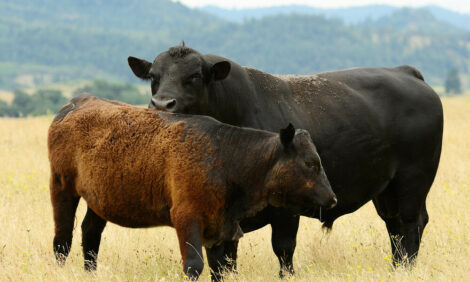



New Vaccine Technology Helps Build BRD Immunity in Young Calves
US - Bovine Respiratory Disease (BRD) is the leading cause of death in beef calves 3 weeks of age or older.A recent multi-university survey of 61 veterinarians in six states provides insights into practitioners’ experiences with BRD in nursing calves, and 87 per cent recommended vaccination of nursing calves to prevent BRD or to shorten the duration of outbreaks. New Once PMH IN from Merck Animal Health is enabling producers to vaccinate calves for BRD as young as one week of age.
Terry Engelken, D.V.M., M.S., associate professor at Iowa State University College of Veterinary Medicine, was involved with the survey, and says it identified risk factors, as well as practitioner recommendations for preventing and managing the disease. A key risk factor mentioned was inadequate colostrum, which could be caused by anything that interferes with the calf standing up rapidly and nursing aggressively.
“We know from extensive research and practical experience that calves not receiving enough colostrum run a higher risk of developing calf scours early in life followed by BRD while they are out on pasture,” says Dr. Engelken.

The losses associated with BRD in nursing calves include both the obvious and those that are not so apparent, writes Dr Brent Myer. Medical expenses, labor costs and death losses are straightforward and easy to calculate. It is more difficult to track weaning weight losses in individual calves after they recover from a bout of BRD.
“Research indicates calves that get sick for any reason during the suckling period will weigh from 20 to 35 per cent less at weaning compared to their healthy herd mates,” says Dr. Engelken.
In addition to the impact on performance, researchers are looking into the affect of nursing calf morbidity on carcass ultrasound characteristics at a year of age.
“Recent work that analyzed the affect of morbidity due to pinkeye,” says Dr. Engelken. “The ultrasound results found that calves that were treated for pinkeye during the nursing period showed a decrease in marbling and ribeye area when measured at a year of age. I would expect similar results for nursing calves that had morbidity due to BRD.”
Developing a BRD Vaccination Program
No single vaccination program fits all, so it’s important to work with a veterinarian to help create a vaccination plan for both dams and calves. The goal of the program is to reduce the disease pressure of the group, which should have a positive impact on the bottom line.
“A veterinarian can identify the risk factors for BRD that reside within the management scheme on an individual farm or ranch, and once they are identified, recommend how to mitigate them,” says Dr. Engelken. “They also will get a handle on the disease pathogens – bacteria or viral – that are circulating and help determine the best timing to vaccinate for these pathogens.”

This process may require sampling of individual calves with BRD or collecting tissues from dead calves and sending the samples to a diagnostic laboratory.
Summer turnout, preweaning and/or weaning are opportune times to prevent disease. Many veterinarians start with a modified live five-way viral vaccine (IBR, BVD1, BVD2, PI3, BRSV) and a dose of “blackleg” vaccine. Other vaccines may be recommended depending on: the potential health challenges present on the ranch; if the operation is on a preconditioning marketing program that requires a certain set of vaccinations; and, how the calves will be managed after weaning, such as if they will be retained through the feedlot.
“Typically, the first additional vaccine would protect against bacterial BRD pathogens, such as Mannheimia haemolytica and Pasteurella multocida,” explains Dr. Engelken.
New Vaccination Technologies
Earlier this year, Merck Animal Health introduced Once PMH® IN – the only intranasal vaccine to deliver dual bacterial pneumonia protection in healthy beef and dairy cattle, including calves as young as 1 week of age. The new vaccine aids in the control of respiratory disease caused by Mannheimia haemolytica and in the prevention of disease caused by Pasteurella multocida.
The intranasal administration stimulates a strong immune response because vaccine antigens are delivered directly to mucosal surfaces in the nose – the major sites of immune response in cattle.
Dr. Engelken was involved with research comparing the intranasal vaccine to a commercially available subcutaneous pasteurella vaccine. Three variables were evaluated: body temperature; weight gain; and, inflammatory protein level response, which is an indicator of infection and inflammation.
“These three variables are related,” explains Engelken. “If a vaccine is more irritating to a calf, the animal will run a higher temperature, have an increase in inflammatory protein levels and, as a result, will not grow as fast. We are literally seeing the calf's protein being directed away from animal growth and toward an unwanted vaccine reaction.”
The results of the studies demonstrated young calves given an intranasal administration of Once PMH IN performed better on body temperature and weight gain measures when compared to calves given a commercial subcutaneous pasteurella vaccine. Calves given Once PMH IN also had a dramatically reduced inflammatory protein level response.
“There are advantages to intranasal BRD vaccines in terms of a rapid onset of immunity, not having to worry about interference from maternal antibody, and these vaccines may be less stressful on the calves than vaccines that are given under the skin,” says Engelken. “These advantages result from the intranasal vaccines working at the point of attack against BRD pathogens – directly in the nose and upper respiratory tract – to provide protection.”
Regardless of what vaccine is used, it’s important to stimulate that calf's immune system at branding time or grass turnout so that we have that protection against BRD on board prior to the time of disease challenge. To learn more about building a BRD prevention program for calves and Once PMH IN, visit www.CattlePrimeVAC.com.
TheCattleSite News Desk


